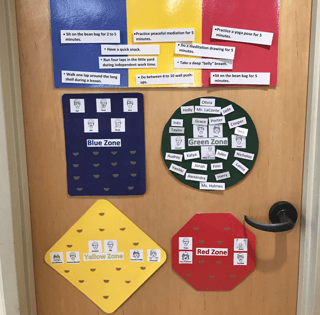By Melissa Holmes and William Laconte
The Zones of Regulation is a conceptual framework used to teach students self regulation and self control. According to the book Zones of Regulation by Leah M. Kuypers, creating this type of system to categorize the complex feelings and states students experience improves their ability to recognize and communicate how they're feeling in a safe, non-judgmental way.
This curriculum teaches students to use strategies or tools to help them move between zones. The Zones of Regulation categorizes states of alertness and emotions into four colored zones. It is important to know that it's fine for students to experience all of these emotions while they're at school. There is no bad zone, but it is important to learn and use strategies that would help students get to their Green Zone.
What are the Zones of Regulation?
(These are the Zones as explained by Leah M. Kuypers)
The Blue Zone
The Blue Zone is used to describe low states of alertness, such as when one feels sad, tired, sick, or bored. This is when one's body and/or brain is moving slowly or sluggishly.
The Green Zone
The Green Zone is used to describe a regulated state of alertness. A person may be described as calm, happy, focused, or content when in the Green Zone. This is the zone students generally need to be in for schoolwork and for being social. Being in the Green Zone shows control.

The Yellow Zone
The Yellow Zone is also used to describe a heightened state of alertness; however, a person has some control when in the Yellow Zone. A person may be experiencing stress, frustration, anxiety, excitement, silliness, nervousness, confusion, and many more slightly elevated emotions and states when in the Yellow Zone (such as wiggly, squirmy, or sensory seeking). The Yellow Zone is starting to lose some control.
The Red Zone
The Red Zone is used to describe extremely heightened states of alertness or very intense feelings. A person may be experiencing anger, rage, explosive behavior, panic, terror, or elation when in the Red Zone. Being in the Red Zone can best be explained by not being in control of one's body.
Strategies at Whitby
In the classroom, students are provided strategies to help them regulate their bodies and get back to the green zone. We created a visual to help remind students of the different strategies they could use in the different zones. These strategies are meant to take no more than 5-10 minutes.

The Blue Zone
- Sit on a bean bag (or in a comfy spot)
- Take a walk
- Go for a short run or jog
- Have a snack
The Yellow Zone
- Meditation or use a calming jar
- Wall pushups
- Have a snack
- Go for a short run or jog
- Meditation coloring
- Take some deep belly breaths
- Yoga
- Meditation coloring
- Take some deep belly breaths
- Sit on a bean bag (or in a comfy spot)
- Yoga
Using the Zones of Regulation at Home
While it's not mandatory to use this program at home, children may become very interested in using this outside of school. For more on this, read The Zones of Regulation - written and created by Leah M. Kuypers, MA Ed OTR/L. The book contains the lessons we are working on along with the language we provide the students with. The book contains cut-outs and other visuals that help the students visualize their various emotions.
If you are interested in using the strategies at home they can be easily implemented. You could make the four Zones signs and strategy board. In the classroom we also made a “blue zone” where it is peaceful and quiet. In this area we included a bean bag chair for students to rest, meditation drawing mandalas, a calming jar, books, and a yoga mat and yoga position cards.

